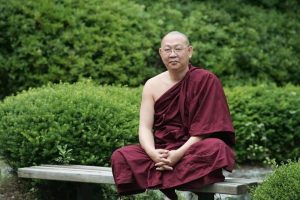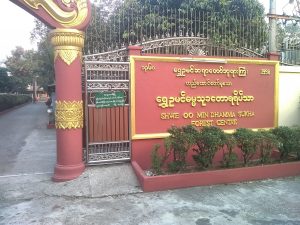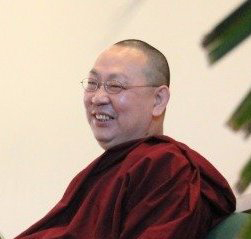
Introduction
If you’re looking to learn the teachings & meditative approach of Sayadaw U Tejaniya (SUT), there is an enormous amount of content on the web, both from SUT himself and others.
In turn, rather than adding more teachings into the mix, this resource guide will instead offer step-by-step suggestions on which resources to put your time/energy into, and in which order to do so.
If you’re not sure who Sayadaw U Tejaniya is, visit this page for a brief bio, or check out his website.
Why these Recommendations?
Different long-time practitioners/teachers might emphasize different aspects of SUT’s teachings; and, in turn, there is certainly a degree of subjectiveness to the ordering and highlighted resources in this guide.
However, what’s listed is born of my own decade-plus of having this as my primary style of meditation, spending two years as a monk with SUT, and also several years of teaching this approach to hundreds of people, both in multi-week courses and 1-on-1 meetings.
I’ve also scoured the web over the years for all things SUT-related (most of it included here), have read all but one of his books multiple times, and have also cross-referenced this list with several other long-time practitioners/teachers. Adding all that together, even if the inclusions or ordering isn’t perfect, it will surely point you in the right direction.
I offer an infinite amount of gratitude to my teacher, Sayadaw U Tejaniya, for his many years of helping meditators actualize the teachings of the Buddha.

Recommendations for Getting Started
(1) Read Relax and Be Aware
For anyone interested in SUT’s teaching, I generally recommend starting by reading Relax & Be Aware. It’s simple and direct, while also being comprehensive and immediately implementable. It features a roughly 50-page overview of the teachings, followed by 31 written guided meditations.
If you’re easily overwhelmed by long guides like this one, just stop here and read this book; it is a tremendous resource!
(2) Two Quick Overviews
SUT has a nice way of distilling his teachings in the opening talk he gives on retreats — here is one such talk, along with a written transcript.
As another quick to-the-core-of-it summary, I would suggest listening to this daylong retreat w/ guided meditations by Andrea Fella (or even just the opening talk). Alternatively, her 57-page SUT-style instruction manual is my 2nd favorite piece of writing intro’ing this practice (after Relax & Be Aware!).
(3) Put it into Practice
From doing either of the above, you already have enough info to start practicing this style. For example, are you aware, right now? Can you maintain that awareness as you read these words? Perhaps doing so with a relaxed attitude?
What about when you wash dishes? Walk around the block? Drive to the store? Or, say, when you sit still with your eyes closed for a half hour?
Basically, this is an approach to meditation that is meant to be done right now; so why not just get right to it!?
(4) Go on a Retreat
The most efficient way to learn this approach is to dive in and steep yourself in it full-time for a number of days (or weeks or months!). The most ideal route is to practice with SUT in person, either flying to Myanmar or doing one of his live retreats abroad. However, with the ongoing civil unrest in Myanmar, this is currently not possible.
Fortunately, there are many places across the world where one can practice this style with experienced teachers. Two recommended routes:
- Search nearby Insight Meditation Retreat Centers for retreats with titles like “Natural Awareness,” or “Mindfulness of Mind,” or “Awareness and Wisdom,” and there’s a reasonable chance they might be SUT-style. You can then often check the bios of the teachers to see if they list SUT.
. - Find the retreats of teachers that primarily teach in this style, such as Andrea Fella, Alexis Santos, Carol Wilson, Lienchi Tran, or any of the teachers listed in the Wisdom Streams directory.
.
- As a somewhat complicating factor, with the exception of Andrea Fella, none of the main North American SUT-style teachers have websites that list all their retreats. In turn, it’s generally a process of searching through the different retreat centers across the country (or world) to find out where they’re teaching. As a quick note, IRC, Big Bear, IMS, and Cloud Mountain are a few among many that usually do at least a couple of SUT-style retreats each year.
. - Hor Tuck Loon is based out of Malaysia, and is one of the more experienced lay teachers in this style; he does Zoom retreats in addition to those that are live in Malaysia. Likewise in Malaysia, the Venerable Kumāra Bhikkhu often leads retreats in this style.
- As a somewhat complicating factor, with the exception of Andrea Fella, none of the main North American SUT-style teachers have websites that list all their retreats. In turn, it’s generally a process of searching through the different retreat centers across the country (or world) to find out where they’re teaching. As a quick note, IRC, Big Bear, IMS, and Cloud Mountain are a few among many that usually do at least a couple of SUT-style retreats each year.
(5) Talk with More Experienced Practitioners / Teachers
It’s enormously helpful to have someone to answer questions and offer some pointers.
The Shwe Oo Min Facebook group is an excellent starting point to ask questions; there are thousands of members who practice in this style, including many who are deeply experienced, longtime monastics, and/or teachers of this approach.
Otherwise, it’s helpful to have contact with someone who is very familiar with this approach, regardless of whether or not they overtly teach it. You might meet these people at a retreat, from a local course/class, or find them online.
Again, the Wisdom Streams directory provides a short list of teachers and dharma communities that draw upon this style.
If you are interested in virtual 1-on-1 mentoring/teaching in this style, below are some teachers experienced with SUT-style who offer 1-on-1s. Check the individual sites to make sure they currently have availability for new students
- Alexis Santos and Susa Talan (scroll down on homepage)
- Mark Nunberg (scroll down to 1:1 Meetings)
- David Sudar (that’s me!)
- Devon Hase
- Li-Anne Tang

Four Ways to Go Deeper
(1) Listen to SUT’s Retreat Talks
On the web, there are full retreat recordings from over 25 retreats he has led. His retreat style is that he gives an opening and closing talk, and then basically all the rest of the “talks” are done Q&A style. If you listen through a whole retreat, you will certainly soak in the essence of this approach.
While you could start with any of them, I recommend beginning with the retreat he led at Spirit Rock in 2015, as it’s got a number of great Q&A sessions as well as many SUT-style guided meditations (entitled “Morning Instructions”). As an added bonus, here are the transcripts for the opening talk and the other morning’s instructions from this retreat.
If you have a little more experience with this approach, I recommend his 2016 Maui retreat, as the retreatants largely had prior experience with this approach, leading to slightly more nuanced questions. If you are more of a reader than a listener, one of his retreats has been transcribed and turned into a book.
Two notes on the retreat recordings:
- There are two basic places to listen to SUT’s retreats online: Archive and Dharmaseed. I prefer Archive when listening straight from the web, as it’s easier to navigate, has a more customizable audio player (if you hit “Beta”), and also has a few retreats and Q&A sessions not listed on Dharmaseed. Note that you can download the talks from both sites, but on Archive you can also download an entire retreat in one click (scroll down to the “downloads” section).
. - For most of his retreats, SUT speaks Burmese, and his interpreter, Ma Thet, relays his answers into English. She spent 10 years as a nun with him and could be a teacher in her own right. There are a few retreats without her, where Sayadaw speaks in English as he does at the monastery to foreigners (for these, search Archive/Dharmaseed for “Shwe Oo Min”). With Ma Thet, he’s a little more articulate, elaborate, and precise. By himself, he’s a little more earthy, direct, and to-the-heart of it. Both have their charm, but I would suggest starting with the Ma Thet retreats (or going to Myanmar to hear from him directly!).
(2) Read SUT’s Other Books
If you live in North America, you can get hard copies of several of these books for free from Wisdom Streams. Otherwise, digital copies of all of his books are available for free on his website, except for Relax & Be Aware and When Awareness Becomes Natural.
After Relax & Be Aware, I usually recommend people read Dhamma Everywhere — it’s longer and goes into more depth, but also has a really nice flow to it, building on itself. Below are brief notes on each of his books:
- Dhamma Everywhere. This is probably his longest and most thorough book, as it explores many of his key teachings in greater depth. The “In a Nutshell” section continues to be my favorite part of any of his books.
. - Awareness Alone Is Not Enough. Overall, this is my personal favorite of all his books, perhaps because it most closely mirrors his actual teaching style, but also because the content goes quite deep. It’s a collection of Q&A on a variety of topics, which means that even though it’s thoughtfully organized, it doesn’t offer any sort of comprehensive or systematic approach. In other words, there are better books to get the hang of his style, but once you’ve got down the basics, this is an incredibly helpful read.
. - When Awareness Becomes Natural. This one is written in a notably different writing style than all his other books; some people love it and others find it harder to get into. Either way, it has the most thorough account of SUT’s life story available in print, largely from Chapters 4 through 6, which was really fun & insightful to read. It’s also the only one of his books available as an audiobook (via Audible).
. - Don’t Look Down on the Defilements, They Will Laugh at You. This was his first book — it’s short, simple, direct, and points to the essence of his wisdom-centered approach. I think Relax & Be Aware is a more polished short intro book, but this one is still fantastic & definitely recommended. It’s also available in 13 languages via his website.
. - Collecting Gold Dust. This book is best for people already familiar with this approach, as it’s written for his existing students. That being said, it’s a delightful read that offers some great pointers, reminders, and reflections for bringing the practice into our daily lives.
. - Jhana Grove Retreat Q&A transcripts. This book was designed as a follow-up to Awareness Alone Is Not Enough. It’s similarly a curated & edited set of transcripts from one of his retreats, but features different questions from the first book. While I loved this one, I mostly just recommend it to people who already read Awareness Alone Is Not Enough and want more of the same!
. - The Practice of Mindfulness Will Change You. The only thing I would highlight from this book is that in the last four pages of Part 1, SUT writes a short spiritual biography (from the mid-2000s).
. - 23 Points on Right Attitude. Before he had any books, back in the early 2000’s, this was the first written teaching that SUT put out. It’s mostly contained in his other books, but is only two pages long and worth a read.
(3) Listen to a Foreign Teacher Retreat
When I was first learning this approach, I found it indispensable to read SUT’s books and listen to his talks. However, it was also incredibly helpful to learn from other deeply experienced practitioners who had spent years learning and internalizing this approach. They explain things with slightly different wording or different contexts, which can help it all click.
Below are a few of the retreat recordings from senior non-Burmese teachers in this style:
- The two-week retreat by Andrea Fella is my top recommendation for someone who wants to really ‘go for it’ with this approach. Of all the SUT-style teachers, Andrea’s publically available teachings are by far the most comprehensive and systematic, while also being very clear and easy-to-understand. However, this retreat features 40+ talks, including instructions and guided meditations, which may be a bigger project than you want to take on. As a note, the core of it is condensed into her highly readable 57-page practice manual.
. - This retreat by Carol Wilson, Steve Armstrong, and Alexis Santos is my top recommendation for someone who wants a more digestible dive into this approach. It’s relatively short, the first two talks alone are incredibly helpful, and it also gives an initial taste of several prominent teachers of this style.
. - This more fluidly taught retreat from Carol Wilson, Mark Nunberg, and Alexis Santos has a number of wonderful pointers and would be good after listening to one of the two above retreats.
. - This one-month retreat from Carol Wilson & Andrea Fella is better for more experienced practitioners, as it was taught to people who already had lots of meditation experience & had a month on retreat to develop it. It includes the basics but goes well beyond them.
As a note, if you search Dharmaseed for any of the above teachers or others on the Wisdom Streams website, you’re likely to find many more retreat recordings in this style.
You can also access recordings of daylong retreats from Alexis Santos and Andrea Fella. I’m sure there are many other daylong recordings out there as well.
(4) Listen to Guided Meditations
While reading and listening to books, talks, and Q&As is incredibly helpful, the essence of this approach is found in doing it. In turn, here are some guided meditations to help guide you into the practice:
- Andrea Fella has over 150 free guided meditations on Audiodharma; not all of them are in this style, but the majority are. I would recommend starting with Receptive Awareness and Noticing the Relationship to Experience. Any others with keywords like relax, allow, awareness, mindfulness, wisdom, etc. are almost certainly this style. Her daylong retreats I linked above are also packed with guided meditations.
. - 10% Happier Guided Meditations. This is a paid app, but Alexis Santos has around 80 guided meditations there, including a course on Practicing Mindfulness in Daily Life. I especially like “Mindfulness of Mind,” “Am I Aware?” and “Understanding Desire.”
. - I’ve recorded a handful of guided meditations in this style, including Right Attitude, Noticing Awareness, Relax, Observe, Allow, and Cultivating Equanimity.
. - Steve Armstrong has a number of excellent guided meditations on Dharmaseed; unfortunately, the audio quality is subpar on most, though this one is top-notch.

A Few More Resources to Check Out
- The Daily Tejaniya. Get a short quote from SUT emailed to you every morning. A great little daily reminder!
. - A short checklist on how to be mindful in daily life.
. - SUT on Youtube. There’s something very humanizing and making-more-real about seeing SUT teach with video.
- My favorite live video recordings from SUT are from this collection of 8 videos, conducted in English at his branch monastery in Kalaw, Myanmar, with a group of foreigners and monks.
. - Here is an intro talk he did in English in the USA, and one with Ma Thet in the USA.
. - Most of his primary Youtube page is just audio, but if you scroll all the way to the bottom, there are about 20 in-person Q&A’s from his monastery in Myanmar.
.
- My favorite live video recordings from SUT are from this collection of 8 videos, conducted in English at his branch monastery in Kalaw, Myanmar, with a group of foreigners and monks.
- Wisdom’s Roar. Put together by a long-time student of SUT, this website features collections of quotes from SUT on key topics, mostly pulled from his retreat recordings. It also features a daily quote. Although, perhaps my favorite feature is their related Soundcloud Page that has single Q&A’s from SUT, so 4 to 12 minutes in length, as opposed to listening to an entire Q&A session.
. - Interviews with SUT
- From 2004, SUT is interviewed by fellow monk, Venerable Kumāra.
. - From 2008, SUT is again interviewed by the Venerable Kumāra; this is perhaps my favorite of all the interviews here, as it shares some of his early entrance into monasticism and teaching, along with the early evolution of this teaching style.
. - From 2007, “The Wise Investigator” is an interview between SUT and Tricycle magazine.
. - From April 2020, guidance on how to relate to the COVID-19 pandemic with Awareness+Wisdom.
.
- From 2004, SUT is interviewed by fellow monk, Venerable Kumāra.
- Various teachers who have online materials on this approach. To list just a handful:
- Andrea Fella’s website has about 20 written reflections on this style of practice. Scroll to the bottom of the page for the writings.
. - Steve Armstrong has a number of excellent writings on practicing SUT-style.
. - I recorded a series of talks based on this approach.
. - Doug McGill has a series of intro talks on SUT’s approach to meditation.
. - Hor Tuck Loon has a massive amount of material on his Soundcloud.
. - While not SUT-style, this article from Gil Fronsdal on Mindfulness of Attitude has helped many meditators get a better understanding of what is meant by “Attitude.”
- Andrea Fella’s website has about 20 written reflections on this style of practice. Scroll to the bottom of the page for the writings.
May this guide be of great fruit and benefit to your practice! If there are any resources you think would be good to add, or have any feedback on how this guide could be improved, please shoot me a message 🙂
